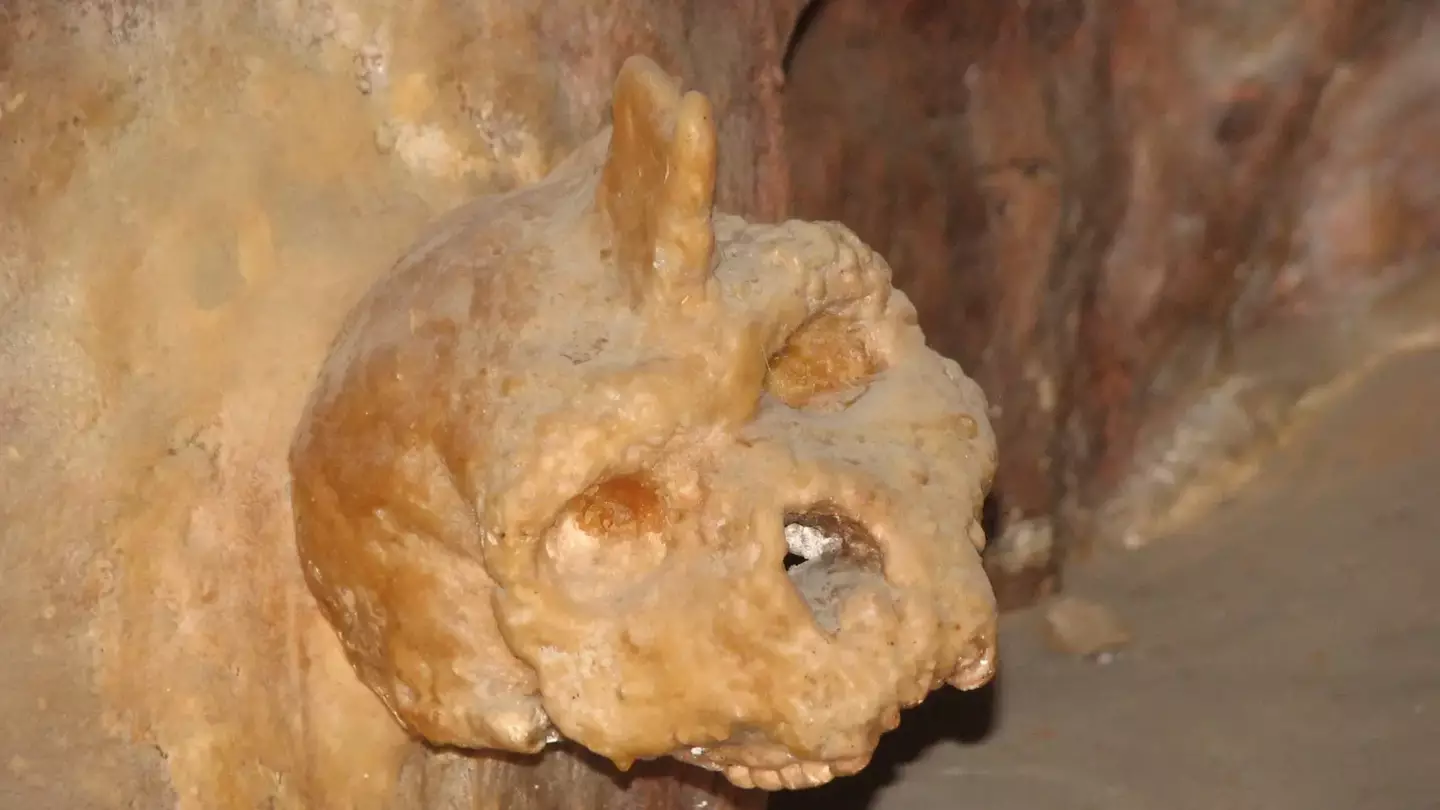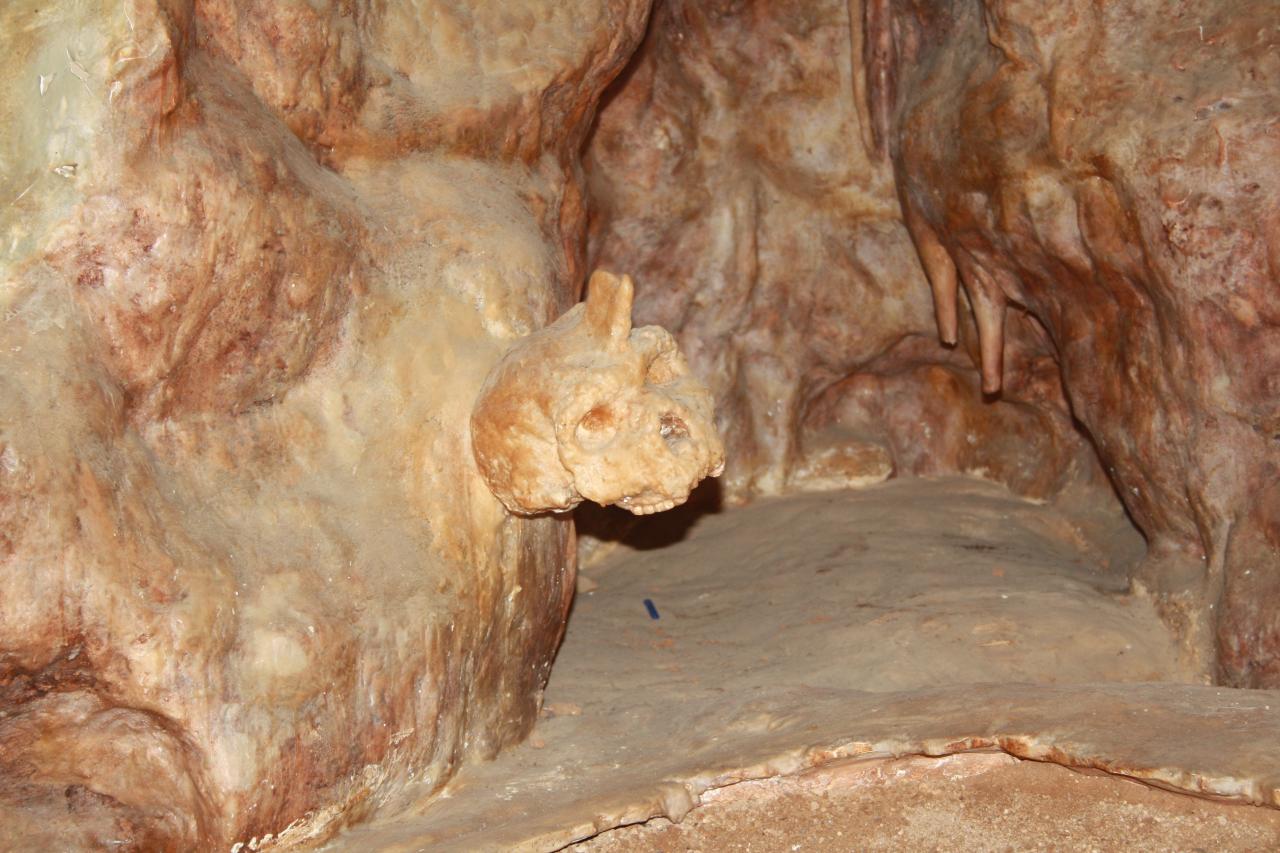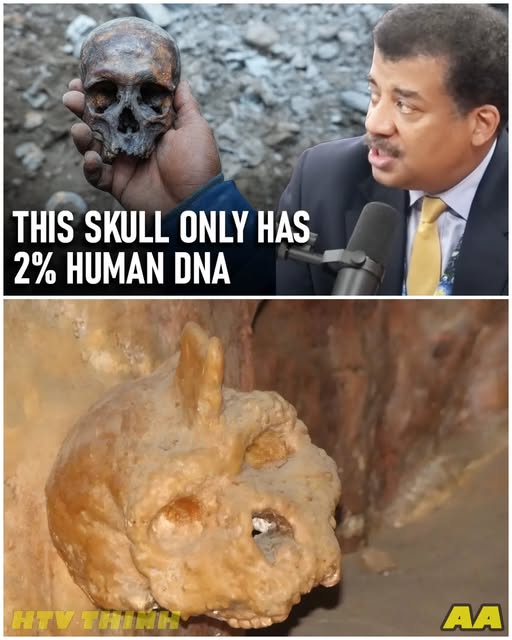
 “Not Human. Not Neanderthal.” The Greek Skull That Shouldn’t Exist—and Why Scientists Are Losing Sleep
“Not Human. Not Neanderthal.” The Greek Skull That Shouldn’t Exist—and Why Scientists Are Losing Sleep 


The cave was discovered the way most inconvenient truths are: by accident.
Petralona, northern Greece, 1959—a villager chasing a draft of cold air through scrub and stone into an opening that wasn’t there yesterday.
He squeezed through the mouth of the earth and dropped into a cathedral of time.
Stalactites hung like frozen lightning.
Stalagmites rose like patient sentinels.
The walls glittered with calcite, a geology of slow applause.
And then he saw it: a skull fused into rock, as if the cave had decided that bone was just another mineral to be arranged and admired.
News traveled.
Scientists arrived with lamps and notebooks and the kind of professional calm that lives one exhale away from awe.
In the beam of a headlamp, the face emerged—brow, orbits, zygomatic flare—too familiar to dismiss, too strange to place.
At first, the labels queued up like reflexes.
Human? Maybe.
Neanderthal? Possibly.
But the measurements refused to cooperate.
The vault, the ridge, the dental arcade—each metric tugged the skull in a different direction, like a jury that could agree on shock but not on a verdict.
For decades, the question sat behind glass while debates raged around it.
Dating the skull became its own saga.
The bone was locked in calcite like an insect in amber, and the matrix wouldn’t yield its clocks easily.
Early estimates tossed the skull around on the timeline like a storm-battered buoy—170,000 years, perhaps more than 700,000.
Every new method felt like a promise; every result felt like a dare.
Then, at last, the lab work that would not be hurried: uranium-thorium readings on the mineral crust.
The numbers arrived cold and unblinking: the calcite was at least 277,000 years old.
The skull, entombed beneath that shell, older still—likely around 300,000 years.
Middle Pleistocene.
An era of ice that came and went like a dangerous mood.

A Europe of predators and prey, of fires coaxed from damp twigs, of hands that learned to teach the next hands.
If the date was a shock, the anatomy was an argument.
It didn’t line up cleanly with us—Homo sapiens were not yet on stage—and it didn’t fit the Neanderthal profile either, despite the familiar depth of the face and the muscle-haunted jaw.
The closest match sidled in from the margins: Homo heidelbergensis, the shadow between ancestors, a complicated node on the family tree where one branch bends toward Neanderthals and another leans toward us.
The Petralona skull seemed to belong to that in-between world, carrying both the archaic weight of an older face and the whisper of features that would later soften into modernity.
But even that label came with splinters.
Some traits were too bold, others too quiet.
The brow spoke in a dialect the textbooks only half understood.
The palate negotiated space like a compromise carved in bone.
Every measurement settled one question and opened two more.
That is how science advances—not in trumpet blasts, but in contested inches.
Imagine the owner of that skull.
A body built for weather that bit and did not apologize.
Shoulders carrying the grammar of spears.
Hands that learned fire the way a child learns a lullaby: painfully, then perfectly, then as though it had always been there.
Eyes adapted to read threat from the angle of grass, track hoofbeats across frozen dirt, recognize kin in a frown.
Not us, not entirely.
But close enough for the recognition to sting.
Close enough to make you want to step out of the cave and look at the stars to remind yourself what survived.
What haunts researchers most is not just the face—it’s the loneliness.
No other bones around it.

No hands to confirm it, no feet to argue for a gait, no tools dropped in the panic of flight, no hearth stones to stain the sediment with old smoke.
Just a skull in crystal, as if the cave itself curated a single sentence from a lost chapter and dared us to reconstruct the book.
Was it deliberate? A burial by companions who cared more than stereotypes allow? Or an accident—rockfall, illness, a misstep in the dark? Did water carry the body away and leave the head behind like a headline
torn from the story? If it was a ritual, it is one the cave keeps.
If it was an accident, it is the kind that rewrites maps.
The 300,000-year timestamp drops the skull onto a crowded stage.
Europe then was not a monoculture of one “type” of human but a busy intersection—archaic lineages negotiating ice and opportunity, Neanderthal ancestors taking shape to the west, other populations threading
their own solutions through forests and steppe.
The Petralona skull says, with the stubbornness of fact, that our past was a chord, not a single note.
We were never alone.
We were never simple.
The last fifteen years have taught us to stop underestimating that chorus.
Denisovans announced themselves from a single finger bone and a tooth and still managed to leave echoes in modern DNA.
The “hobbits” of Flores crowded into our imagination with their tiny bodies and enormous implications.
Harbin’s “Dragon Man” stepped forward from China with a face that forced genealogies to redraw themselves in real time.
Each arrival erases another easy story.
Petralona stands with them, a European voice saying the continent held more than one way to be human long before we arrived to monopolize the narrative.
Not everyone buys Heidelbergensis as the answer stamped on the specimen’s passport.
Some insist the Petralona face is too idiosyncratic, that it represents a branch we have not yet named, a lineage smoothed out of existence by climate and competition, leaving only this one crystalized argument
behind.

That possibility is seductive and terrifying in equal measure.
It means the family tree isn’t a tree at all but a braided river—channels splitting, rejoining, disappearing underground, resurfacing miles later with a new name and the same water.
The cave amplifies the uncertainty.
Petralona is a machine for making time visible: drip by drip, calcite builds its slow armor, sealing bone to stone, disguising edges, preserving secrets with the indifference of geology.
The very beauty that saved the skull also censored it—mineral overprint blurring sutures, smearing seams, denying the fine-grained data osteologists crave.
We have a face.
We do not have a biography.
So we write the middle with care and audacity.
We imagine a winter hunt—wind carving the hills, a river loud with floating ice, a small band sheltering in limestone lit by the shy orange of pine resin.
We imagine a fall, a fever, a fight.
We imagine grief sophisticated enough to move a head to a place where stone would guard it, or chaos indifferent enough to abandon it where dripwater would consecrate it by accident.
We imagine, because the brain is a lantern that hates dark corners.
Meanwhile, the labs keep grinding.
New scans peer through calcite with wavelengths that turn stone briefly transparent.
Micro-CTs map interior chambers; enamel chemistry reads childhood diets like a ledger.
Uranium series clocks are cross-checked against cave growth rates.
Each method takes a respectful bite, and the skull yields another millimeter of meaning.
Every advance confirms the part that matters most: deep time and near-humanity staring out from the same face.
It should feel distant.
It doesn’t.
Perhaps that is why this skull frightens even as it fascinates.
It reminds us that “human” is not a gate we alone were destined to pass, but a threshold many approached, some crossed, and others touched with their fingertips before the weather turned.
It reminds us that survival is not a synonym for superiority; it is merely what was left after chance and climate and catastrophe finished their edits.
In that sense, Petralona is a mirror that adds a second reflection behind yours.

Look long enough and you see a companion in the glass—thicker brow, broader face, different answers to the same cold—and you understand that history is not a march but a negotiation held at the edge of
firelight.
The skull also exposes our craving for clean stories.
We want ancestors to line up like soldiers.
We want dates to behave and bones to vote unanimously.
Instead we get noise, overlap, admixture—threads spliced and respliced until certainty frays.
The temptation is to drag the unknown into familiar myths: lost civilizations, forbidden lineages, narratives that flatter our hunger for shock over truth.
But the actual revelation here is humbler and more devastating: the world has always been more crowded than our categories.
Petralona’s silence has its own eloquence.
In the absence of a skeleton, context becomes a suspect confessed by the scene.
The cave’s stalagmitic flowstone whispers climate; the microfauna in adjacent sediments sketch a habitat; trace charcoal, if it’s ever found, could prove a hearth.
That is why excavations continue with tweezers and patience.
A tool fragment, a cut-marked bone, a flake scar on a cobble—any one of these could pry open the door the skull has only cracked.
Until then, it sits inside its mineral halo, daring us to make mistakes and learn from them.
The shock echoes far beyond Greece.
If Europe held multiple experimentations in humanity 300,000 years ago, how many vanished rehearsals of “us” played out in Africa’s rifts, in Asia’s river basins, under Amazonian canopies that bury cities and
then pretend nothing happened? Each new find is a vote against arrogance.
Each odd bone is a veto on inevitability.
We are the last draft, not the only draft.
That is the skull’s quiet threat and gift.
There is a moment, standing before the glass, when the room falls away.
The calcite gleams like frost.
The orbits darken, and the weight of stone and time compresses into a pressure you feel behind the sternum.
It is not fear.
It is recognition.

The face in the rock is almost us, but not quite—near enough to love, far enough to lose.
The distance between those two truths is where science lives and where myth is tempted to step in.
The skull refuses myth the easy victory.
It offers harder work instead: measurements, arguments, revisions, humility.
A better story, because it is earned.
The rest is up to the cave and to us.
Somewhere under Petralona’s dripping ceiling, there may be a scat of charcoal waiting to say fire was here; a snapped tip of a wooden spear mineralized into permanence; a molar from a companion who stood
watch while dripwater rehearsed its future prison.
Or there may be nothing else at all, and we must honor the single voice we have.
Either way, the meaning holds: humanity is not a lineage that marched; it is a choir that mingled, fell silent, began again.
The Greek skull sings a part we didn’t know we were missing until it rang in crystal.
And when you turn from the glass and catch your reflection in the museum window—a modern face under modern light—you feel the thread pulled taut through time.
You are not an endpoint.
You are a survivor of many almosts.
The skull knew that long before you did.
